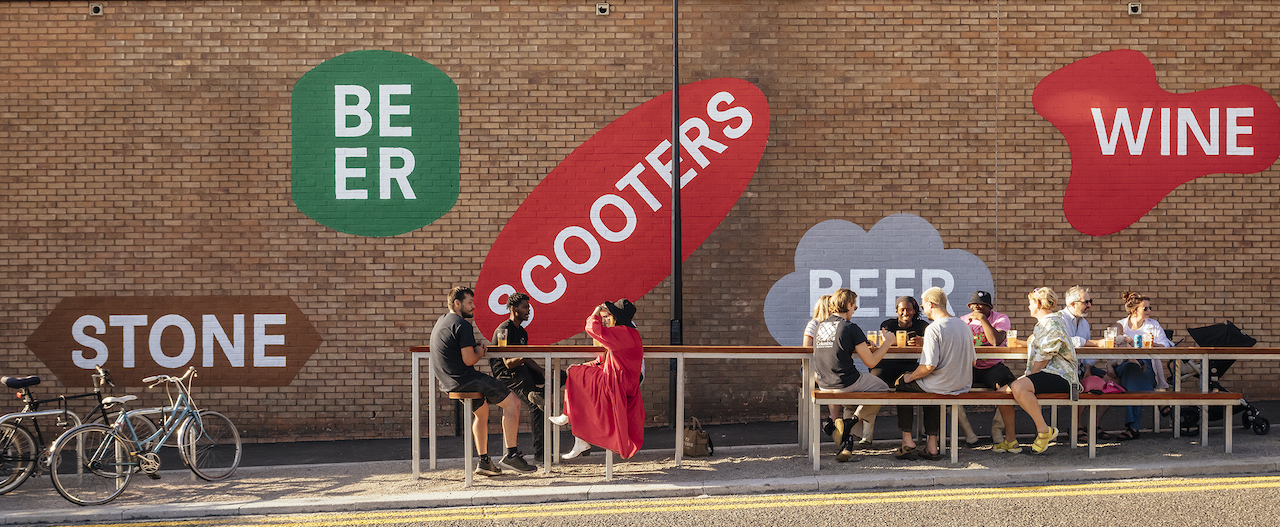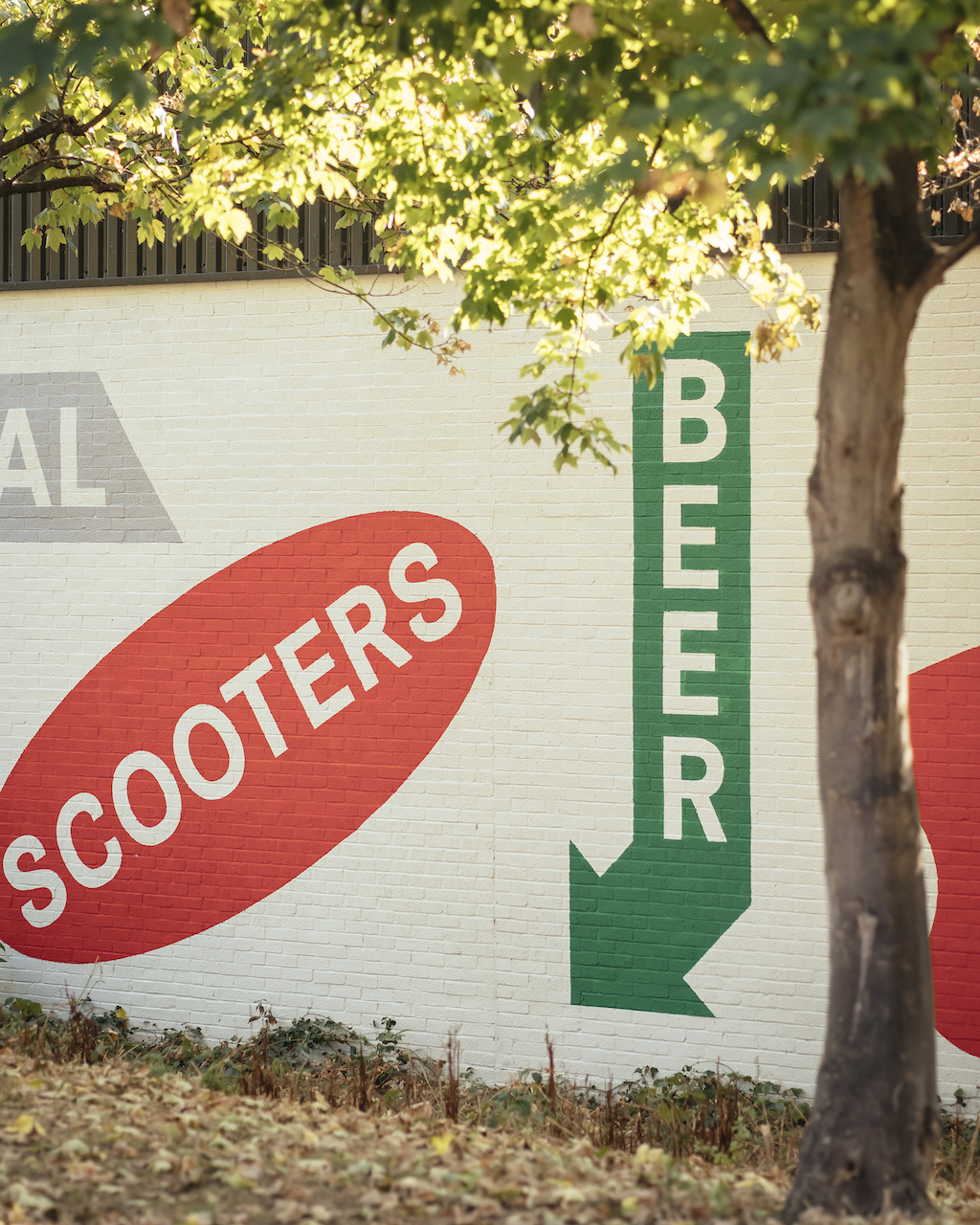Post
Working in partnership with developers and businesses can create sustainable regeneration
25 Oct 2023
Improving the Lockwood Way industrial estate in Blackhorse Lane, has transformed the area into a social hub for local businesses and expanding the tap rooms on the Walthamstow Beer Mile.
Mark Flynn, project architect at We Made That explains how he and his team turned Lockwood Way industrial estate on Blackhorse road into a thriving social hub for local business and expanded the Walthamstow Beer Mile.
Looking back
In the short film we commissioned to document the project, we interviewed a number of tenants on the estate about the delivered interventions and the successes of the project.
Described in the video as “the whole is greater than the sum of the parts” - the combination of the new vibrant artworks, seating, shelter, lighting, trees and greenery that were introduced means it's now a place where people want to spend time rather than what was previously described as a "tatty car park" filled with "rubbish and bins".
Check out our rundown of upcoming events
It’s notable that people now pick up their bakery and coffee order and gather on the long table and bench structure opposite, where workers on the estate also sometimes sit with their lunch. People order their beer from inside either of the two breweries and sit together outside underneath the new canopy - or stand in a circle around the many steel planters, resting their pints on the timber edges.
The delivered public realm interventions have been key to drawing out the activity from inside the units and making the estate a vibrant place, especially in the summer when the estate is flooded with people, including young families, attending one of the many events arranged by the breweries. Working on a project that was able to successfully remove a significant amount of car parking and introduce trees and greenery could be seen as a big win – when this is so often a difficult thing to deliver.
Subscribe to the London Society newsletter
Lockwood Way now feels like a ‘place’ where people should be, rather than a forgotten and unwelcoming edge. A large part of the success of the project was down to the willingness of the tenants to push for interventions that balanced the newer public-facing uses with the existing light industrial activity in a way they could successfully co-exist, making the estate a better place for all.
Working with the breweries
Wild Card Brewery was one of the key stakeholders and consistently proactive in engaging with us and the design processes throughout the project, whether through workshops, in-person meetings or Zoom calls. They provided us space in the tap room to host the co-design workshops at the early design stages to discuss initial ideas and set the direction of the project.
In these sessions, Wild Card advocated for introducing greening, communal street furniture and the infrastructure to support events into the public realm, the removal of the car parking strip, and to open up some of the units with glazed frontages which has since allowed them to sublet the spaces and bring in new uses to the estate, such as a bakery and a now a barber.
The idea of the movable planters and seating that could be moved with the tenant’s forklift trucks on the estate also came out of these sessions. Wild Card Brewery, Hackney Brewery and Renegade Urban Winery all agreed to be ‘guardians’ of the movable furniture and use them in their yard spaces.
Wild Card was particularly keen that the estate became safer and a place that people felt like spending time, especially for women at night. The team also pushed for more large-scale ideas such as introducing the infrastructure to support outdoor film screenings and a shared silo for storing the spent grain from the brewing process, however in the end these were unable to be implemented within the construction budget.
As organisers of the Walthamstow Beer Mile, they had the ‘bigger picture’ thinking of Lockwood Way becoming more of a weekend destination - especially combined with the proximity to the adjacent Wetlands - and were supportive of opening up a second entrance on the estate to the Wetlands to better facilitate movement between them.
Hackney Brewery moved in towards the end of the design stages of the project but we were able to liaise with them to deliver acoustic fencing to the perimeter of their external yard space, which would allow them to play music and host events without impacting the nearby residential areas.
Client feedback
The Council is committed to ensuring that new housing in the area attracts investment and provides lasting benefits to the whole community, and in particular supports this designated Creative Enterprise Zone, the “Blackhorse Collective”. This project was a culmination of the hard work and dedication of architects, We Made That, BRAC contractors, the local business community, Council staff and other key project partners who all contributed to the success of this project.
Lockwood Way is an example of how working in partnership with developers and having intensive engagement with businesses can bring forward sustainable regeneration, with new homes in the area supporting investment in the local community.
The Blackhorse Lane area has a rich heritage, and for many years was a thriving industrial hub driving economic growth that provided jobs and training opportunities for residents. In more recent times, the Lockwood Way Industrial Estate has become a home for a broad variety of creatives, makers, and artisans who have transformed it into a bustling hub of culture and small businesses.
Lockwood Way sits within the Mayor of London’s Upper Lee Valley Opportunity area and is also a designated Creative Enterprise Zone. We have a fantastic opportunity to build upon the area’s heritage to support the new industries finding their way and help local up-and- coming talents establish themselves.
We are delighted to have worked with We Made That Architects alongside local businesses to improve the area. The Lockwood Way project is an amazing opportunity to highlight the skills and services available in the borough, support local business growth and create jobs, and protect the breadth of creative diversity in the area.
The businesses at Lockwood Way have taken ownership of the improvements, which was celebrated through an event in July last year that they helped organise.
- Jimmy Jemal, Waltham Forest Council, Regeneration Delivery Lead, Blackhorse Lane (client)
“We have seen over the last year – and the through Covid-19 pandemic – that now more than ever residents have developed a new appreciation for their neighbourhood, while getting to know the nearby shops, cultural hotspots and high-quality green spaces that has always been on their doorsteps. The Lockwood Way improvements keep investment in the heart of the borough and provides even more choice for the local community and instils confidence in the future for our residents.”
- Stewart Murray, Waltham Forest Council’s Strategic Director for Economic Growth

